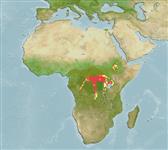Actinopterygii (ray-finned fishes) >
Siluriformes (Catfish) >
Clariidae (Airbreathing catfishes)
Etymology: Clarias: Greek, chlaros = lively, in reference to the ability of the fish to live for a long time out of water. More on author: Fowler.
Environment / Climate / Range
Ecology
Freshwater; demersal. Tropical, preferred ?
Africa: middle Congo River basin, Lake Albert system and Malagarasi basin (Ref. 248, 78218). Also reported from the lower Lualaba (Ref. 106245).
Size / Weight / Age
Maturity: Lm ? range ? - ? cm
Max length : 19.6 cm TL male/unsexed; (Ref. 3820)
Short description
Morphology | Morphometrics
Dorsal
spines
(total): 0;
Dorsal
soft rays
(total): 76-87;
Anal
soft rays: 63 - 69;
Vertebrae: 60 - 64. Head rectangular to oval-shaped dorsally; snout broadly rounded; eyes laterally placed. Frontal fontanelle long and narrow; occipital fontanelle small and oval-shaped. Supraorbital and `dermosphenotic' bones separate but not reduced. Tooth plates broad. Pectoral spine slightly curved; outer side with strong, downward serrations. Gill rakers short and squat, although distantly set. Suprabranchial organ rather primitive. Openings of the secondary sensory canals display a regular pattern.
Life cycle and mating behavior
Maturity | Reproduction | Spawning | Eggs | Fecundity | Larvae
Teugels, G.G., 1986. A systematic revision of the African species of the genus Clarias (Pisces; Clariidae). Ann. Mus. R. Afr. Centr., Sci. Zool., 247:199 p. (Ref. 248)
IUCN Red List Status (Ref. 115185)
CITES (Ref. 94142)
Not Evaluated
Threat to humans
Harmless
Human uses
More information
Common namesSynonymsMetabolismPredatorsEcotoxicologyReproductionMaturitySpawningFecundityEggsEgg development
Age/SizeGrowthLength-weightLength-lengthLength-frequenciesMorphometricsMorphologyLarvaeLarval dynamicsRecruitmentAbundance
ReferencesAquacultureAquaculture profileStrainsGeneticsAllele frequenciesHeritabilityDiseasesProcessingMass conversion
Tools
Special reports
Download XML
Internet sources
